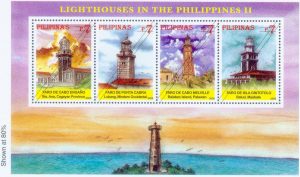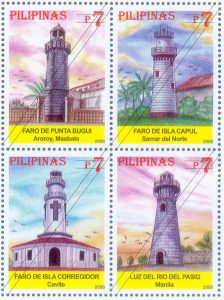Trivia about the Colonial Lighthouses in the Philippines II
FARO DE CABO ENGANO, Palaui Island, Santa Ana, Cagayan Province – Situated on the northern most tip of the island, the lighthouse, finished in 1892 is accessible via an hour banca ride from the town of Santa Ana, the last town on the north eastern tip of Luzon. The lighthouse situated on a bluff overlooking both the Babuyan channel and Pacific Oceans originally contained a first lens. Though today in partial ruin, the lighthouse in Cabo Engano still projects that haunting allure that makes this lighthouse a beautiful structure to see.
FARO DE PUNTA CABRA, Isia de Cabra, Lubang, Mindoro Occidental – Straddling the edge of this flat island, the lighthouse of Cabra, built in 1889 is situated in a surreal bucolic setting of peanuts and the sea, the impoverished island and another 30 minutes banca ride to the island of Cabra. Cabra lighthouse is one of the few lighthouses in the country that still contains its entire original fitting including its 19th century furniture.
FARO DE CABO MELVILLE, Balabac Island, Palawan – The farthest and most difficult if not tiring to visit is the lighthouse in Balabac Island, Palawan, built in 1892. Situated in the ride from Puerto Princesa to Rio Tuba, from there it’s a three hour banca ride to the town of the island. The lighthouse in Cape Melville is the most preserved of all Spanish built lighthouses in the country.
FARO DE ISLA GINTOTOLO, Balud, Masbate – Faro de Gintotolo belonged to one of the original 24 lighthouses initially erected by the Spanish Colonial Government in the country. The Sibuyan Sea, one of the major intersections for navigators in the Visayas is a byway for ships heading to either the Ports of lloilo or Cebu. It functions in unison with the lighthouse on Sibulac-Babac de Gigantes. Ramon de Ros designed the project with modifications done on the 9th of September 1895 by Primitibo Lluelmo.
FARO DE PUNTA BUGUI, Aroroy, Masbate – There is no easy way of getting to this lighthouse, which was built 1896. The site selected for the lighthouse was a narrow plateau 50.90 meters above sea level. The plans were prepared by Guillermo Brockman and signed on the 31st of July 1891. The lighthouse was made operational on the 9th of October 1896. Though today its roof has been blown away, Faro de Punta Bugui still retains its unique charm. This isolated lighthouse in the edge of Masbate still retains its original 3rd order lens and much of its detail work.
FARO DE ISLA CAPUL, Northern Samar – Located on the north point of the island of the same name, 165 yards from its extremity. It lights the western entrance to Estrecho de San Bernardino between the Islands of Samar and Luzon, and the southern route from the Pacific Ocean across Mindoro Sea to Manila, via the Verde Passage. Situated on the northern most tip of Isia de Capul the lighthouse, built on a clearing on top of the hill overlooks the narrow passage separating the island from the Port of Matnog in the island of Luzon. It was lit and made operational by the first semester of 1896. The design of the complex was prepared by Guillermo Brockman.
FARO DE ISLA CORREGIDOR, Cavite – The lighthouse was heavily damaged during the war. This historic light station was recently restored with funds from the Spanish Government. The lantern was replaced with modern equipment by the Japanese Government. The Pacific War Memorial is nearby. Located at the highest point of the island, known as Topside. Site and tower open.
LUZ DEL RIO DEL PASIG, Binondo, Manila – It is the oldest light station in the country built in 1642 during the administration of Governor General Sebastian Hurtado de Corcuera, centuries ahead of its successors. Erected to protect the country’s flourishing maritime industry in the time of the Galleon Trade, the Pasig Farola is located atop a dike with a fixed beacon which can be seen from as far as corregidor, 27 miles away. When the Manila-AcapuIco galleon trade came to an end, the country joined an extensive network of international trade and commerce, which required more shipping routes to and from the island.
Stamps featuring the Colonial Lighthouses in the Philippines II


Recent Comments